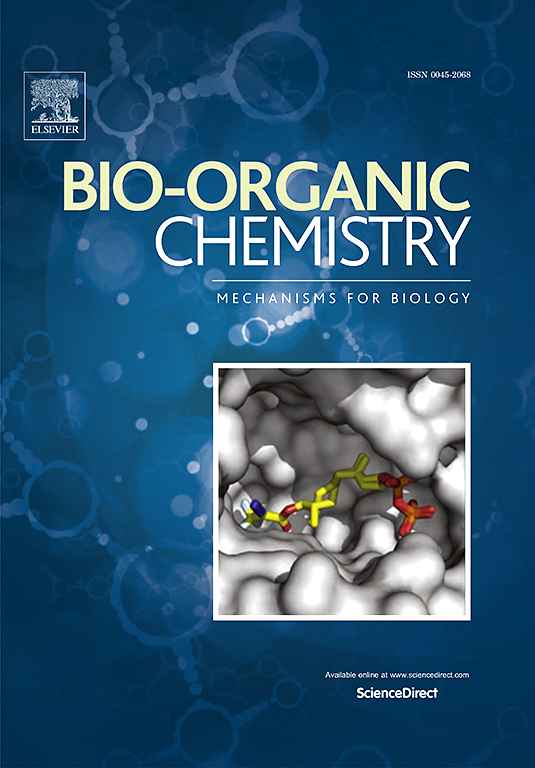Modulating culture method promotes the production of disulfide-linked resorcylic acid lactone dimers with anti-proliferative activity
IF 4.5
2区 医学
Q1 BIOCHEMISTRY & MOLECULAR BIOLOGY
引用次数: 0
Abstract
Sulfur-containing natural products are distinguished by their unique chemical structures and notable biological activities, rendering them highly valuable in drug discovery and development. Recent advancements in chemical epigenetic modifications, sulfur source regulation, and fungal co-cultivation have significantly facilitated the discovery of novel sulfur-containing compounds. In this study, the modulating culture method, incorporating DMSO and sea salt into the culture medium, was utilized to induce the marine-derived fungus Penicillium sp. to produce novel disulfide-linked resorcylic acid lactone dimers, dipenirestone A and B (1 and 2), along with their monomeric precursors (3−13). The absolute configurations of the new compounds 1–6 were elucidated through calculated NMR and ECD methods, as well as X-ray crystallography. Notably, the dimeric compounds (1 and 2) exhibited significantly enhanced anti-proliferative activity against HGC-27 cells compared to the monomers 3–13. It was revealed that compounds 1 and 2 exerted an antiproliferative effect through the modulation of the PI3K/AKT/mTOR signaling pathway. This was manifested as cell cycle arrest in the G1 phase, reduction in mitochondrial membrane potential, and induction of apoptosis.

含硫天然产物具有独特的化学结构和显著的生物活性,因此在药物发现和开发方面具有极高的价值。近年来,化学表观遗传修饰、硫源调控和真菌共培养技术的进步极大地促进了新型含硫化合物的发现。本研究利用在培养基中加入二甲基亚砜(DMSO)和海盐的调控培养法,诱导海洋源真菌青霉产生新型二硫键树脂酸内酯二聚体二苯酮石 A 和 B(1 和 2),以及它们的单体前体(3-13)。通过计算 NMR 和 ECD 方法以及 X 射线晶体学,阐明了新化合物 1-6 的绝对构型。值得注意的是,与单体 3-13 相比,二聚化合物(1 和 2)对 HGC-27 细胞的抗增殖活性明显增强。研究发现,化合物 1 和 2 通过调节 PI3K/AKT/mTOR 信号通路发挥抗增殖作用。这表现为细胞周期停滞在 G1 期、线粒体膜电位降低和诱导细胞凋亡。
本文章由计算机程序翻译,如有差异,请以英文原文为准。
求助全文
约1分钟内获得全文
求助全文
来源期刊

Bioorganic Chemistry
生物-生化与分子生物学
CiteScore
9.70
自引率
3.90%
发文量
679
审稿时长
31 days
期刊介绍:
Bioorganic Chemistry publishes research that addresses biological questions at the molecular level, using organic chemistry and principles of physical organic chemistry. The scope of the journal covers a range of topics at the organic chemistry-biology interface, including: enzyme catalysis, biotransformation and enzyme inhibition; nucleic acids chemistry; medicinal chemistry; natural product chemistry, natural product synthesis and natural product biosynthesis; antimicrobial agents; lipid and peptide chemistry; biophysical chemistry; biological probes; bio-orthogonal chemistry and biomimetic chemistry.
For manuscripts dealing with synthetic bioactive compounds, the Journal requires that the molecular target of the compounds described must be known, and must be demonstrated experimentally in the manuscript. For studies involving natural products, if the molecular target is unknown, some data beyond simple cell-based toxicity studies to provide insight into the mechanism of action is required. Studies supported by molecular docking are welcome, but must be supported by experimental data. The Journal does not consider manuscripts that are purely theoretical or computational in nature.
The Journal publishes regular articles, short communications and reviews. Reviews are normally invited by Editors or Editorial Board members. Authors of unsolicited reviews should first contact an Editor or Editorial Board member to determine whether the proposed article is within the scope of the Journal.
 求助内容:
求助内容: 应助结果提醒方式:
应助结果提醒方式:


